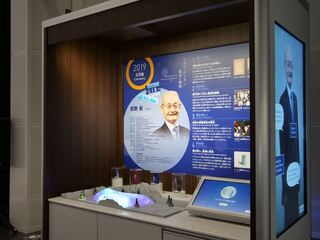Nagoya City Science Museum
TOP > Exhibition Guide > Floor Map> Akira Yoshino
Akira Yoshino



Purpose of Exhibition
In 2019, Akira Yoshino, along with M. Stanley Whittingham and John B. Goodenough, were awarded the Nobel Prize in Chemistry “for the development of lithium-ion batteries.”
Batteries, which produce electricity through a chemical reaction, can be broadly classified into two categories: primary batteries, which are disposed of after one use; and secondary batteries, which can be recharged and used repeatedly. These secondary batteries are indispensable for our phones, computers, video cameras, and other portable electronic devices that are usable without being plugged into an electrical outlet. They meet customer needs for a secondary battery that is compact, lightweight, and high-capacity.
By focusing on special carbon-based materials, Yoshino was able to build a prototype lithium-ion battery incorporating lithium cobalt oxide, which previous research had shown to be a superior material, as the positive electrode. Through prototyping with this carbon-based material as a negative electrode, and by consulting with users, he was able to develop the new battery that is now in widespread use.
Today, these batteries are used in smartphones and other indispensable electronic devices, and new future applications continue to attract interest.
Additional Knowledge
High Unit
The High Unit exhibit introduces Akira Yoshino and the details of his Nobel Prize-winning research. It also covers his background, events from his school days, and episodes from his life as a researcher.
The counter exhibit highlights Yoshino’s journey through the world of R&D and presents his unique perspective as a researcher employed in the corporate sector. The R&D Process exhibit is divided into three parts: the Devil’s River, the Valley of Death, and the Sea of Darwin. We invite you to read about the hardships he encountered in each step and the ingenuity he displayed in order to overcome them.
How lithium-ion batteries work
Lithium-ion batteries incorporate many inventions developed by Akira Yoshino, and their structure is very well thought out to ensure they deliver ample electric power despite their compact size. The production process for these batteries also reveals much ingenuity. In this exhibit, the structure of these batteries is introduced through enlarged models, and the production process is introduced through video.
Electrode Card Battle
In our day-to-day lives, we are surrounded by lithium-ion batteries and various other types of batteries. These batteries use different materials for their electrolytes and for their negative and positive poles. The various combinations of these components determine characteristics such as electromotive force. In this exhibit, you can construct a practical battery with various combinations of electrodes by selecting electrode cards from the cards available on the board. In this Electrode Card Battle, players compete to make a practical battery with the greatest electromotive force. After the competition, we introduce the principles of practical batteries made with the above combinations, so be sure to take part in the card battle.
Creating the Future with Lithium-ion Batteries: The Secret Story of Their Development with Inventor Akira Yoshino (2016), Akira Yoshino, CMC Publishing
The Energy Revolution Created by Batteries (2017), NHK Culture Radio Science and Humans, Akira Yoshino, NHK Publishing
Chronological Scientific Tables 2019, National Astronomical Observatory of Japan, Maruzen Publishing
Note: The above were published in the Japanese language. Titles are translated for convenience.
